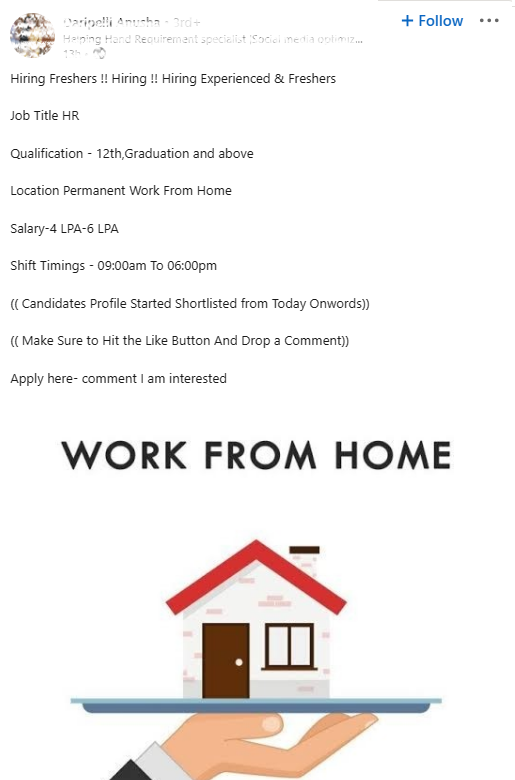How to Easily Identify Fake Job Posts on LinkedIn

LinkedIn has become a thriving hub for professionals seeking job opportunities and networking. However, between the valuable connections and genuine opportunities, there is a growing problem: Unprofessional and fake job posts on Linkedin.
As I started using LinkedIn more, I saw a lot of job posts that seemed like spam. It felt like these posts were made just to bother people, and they didn’t actually want to hire anyone. It’s important to be careful and smart when you see these kinds of posts because they usually don’t lead to real job opportunities and can cause more problems than opportunities.
In this article, I will discuss fake employers on LinkedIn, fake job posts, and explain why they are created, how they exploit job seekers, and their underlying motives. Additionally, I will cover how to identify and avoid falling victim to these scams. This guidance will not only help you protect your data but also save your time and focus on legitimate job opportunities.
Fake Job Posts on LinkedIn
What are fake job posts on LinkedIn?
Fake job posts are job listings that are either not genuine or intended to trick job seekers. These posts often ask you to send your information, like your resume or personal details, but they don’t have a real job to offer.
They might try to sell you something or collect your information for bad purposes, like sending you unwanted emails. So, it’s important to be careful when you see job posts that look suspicious or too good to be true.
How do fake job posts on LinkedIn work?
Fake employers (AKA Spammers) request you to send your CV (which has all your details), and they store it in their database. However, they never get in touch with you regarding a job because, in reality, there was never a job opportunity to begin with.
Why do spammers use fake job posts on LinkedIn?
Fake job posts can be quite successful in gathering people’s information. Consequently, some companies are willing to pay for your data for marketing reasons. They actually spend real money just to learn a bit about you. Then, they sell this information to other companies that want to advertise their products or services to the right audience—people who are likely to be interested in what they offer.
Why do spammers love LinkedIn?
Spammers use LinkedIn because they know that many genuine job seekers are present and often willing to share their personal information.
How to Identify Fake Job Posts on LinkedIn?

🟥 They don’t have a website
Fake job posts typically originate from an unknown company or individual. They don’t have an official website.
🟥 They don’t have a business email
While some fake employers may use a business email address, it’s important to note that most of them do not. Instead, they typically rely on free email services like Gmail, Outlook, Hotmail, etc.
🟥 The job information is incomplete
Fake job posts on LinkedIn often leave you wondering if you’re the right fit because it’s incomplete and appear to be written by someone who isn’t genuinely seeking your skills but your personal information.
🟥 They focus on your information
You’ll notice that all they ask for is your CV because, as mentioned before, fake job posts are only interested in collecting your personal information.
🟥 They use regular posting
Posting jobs on LinkedIn comes with its own set of features. However, if an employer uses a standard post to seek a candidate, it may raise suspicion and appear spammy.
Bottom line:
Avoid job ads without a real website or business email, ones with unclear job info, and especially those super interested in your CV and personal info.
Update: Real-life Example of Fake Job Posts
One of my LinkedIn connections mentioned me in a fake job post after I published this article, and, consequently, I’d like to share it with you to provide an example of what a fake job post looks like.

Let’s analyze the job post based on the previous section ‘How to Identify Fake Job Posts on LinkedIn?‘.
I’ll start, step by step:
- It looks suspicious – it has a low-quality image, and it’s asking job seekers to like and comment on the post. WTH?! 😅
- No official website found
- No business email address found
- Job information is incomplete
- Employer is focusing on personal information
- They’re using regular posting instead of a job post
🟥 Fake job post confirmed!
Investigative Steps to Spot Fake Job Posts on LinkedIn
🏢 Google the employer’s business
Before you apply for a job, consult your trusty friend, Google. Search for the employer’s website and make sure it shows up in the search results. Also, check if there’s any relevant content about that website on the first page of Google. This will give you a sense of the website’s legitimacy.
🔍 Scan the employer’s profile
When you’re on LinkedIn and want to make sure someone’s profile is real, keep an eye out for clues. Look at their picture – if it seems too perfect, it might be fake. Also, check if they’ve filled out their job history and education. If it’s really short or has mistakes, however, be careful. Fake profiles often don’t have many friends or recommendations. Additionally, if their job titles seem strange, that’s a warning sign too. If something doesn’t feel right, it’s okay to ask your shared friends about them. Always stay safe and avoid sharing personal info with people you’re not sure about.
🛡️ Use Website Scam Detecting tools
Website scam-detecting tools:
If the employer has provided a website, and you still have doubts, you can use the Google Safe Browsing tool or Scamadviser to scan their website for malicious content and measure trust rate. This can help you assess the website’s trustworthiness.
Using the tools is straightforward. Simply open them, enter the website’s URL address, and click “Enter.”
Real report examples:
While these tools are not guaranteed to spot a fake job post, they can protect you from malicious and suspicious employers.
🧐 Trust your intuition
While tools can help find fake job posts, your inner feeling can notice small signs that aren’t obvious. If a job feels strange or makes you uneasy, it’s okay to be careful and look for different jobs.
🤝 Don’t Hesitate to Ask for Help
You can always reach out to me for assistance if you receive a job offer on LinkedIn and you’re unsure of its authenticity. Simply leave a comment or send a private message, and I’ll be happy to help.
Bottom line:
Remember to be careful when looking for jobs. Use Google to check the employer’s website, look for signs on LinkedIn, and use safety tools like Google Safe Browsing and Scamadviser. And if you ever feel unsure, don’t be afraid to ask Mohamed Soufan for help – your safety is important!
FAQs
Are there spammers on LinkedIn?
Yes, spammers are everywhere, and LinkedIn is no exception. You should always be cautious when connecting with people and receiving job offers on LinkedIn.
What is the most used spam method on LinkedIn?
The most common spam method on LinkedIn is job posting spam, where scammers request your CV for a supposed job opportunity but never follow up, using this as a means to collect your personal information.
What are fake job posts on LinkedIn?
Messages or job postings that promise high-paying jobs but are actually scams are designed to collect your personal information, which is then sold to other companies for marketing purposes.
How to identify fake job posts on LinkedIn?
Use Google to check the employer’s website, look for signs on LinkedIn, and use safety tools like Google Safe Browsing and Scamadviser. And if you ever feel unsure, don’t be afraid to ask experts like Mohamed Soufan for help – your safety is important!
Who is Mohammad Soufan?
Mohamed Soufan is a software engineer and cybersecurity expert, ranking in the top 5% of 1.4M LinkedIn experts. His dedication to safeguarding digital assets and continuous pursuit of knowledge sets him apart.
Conclusion about Fake Job Posts on LinkedIn
In conclusion, it’s important to be careful when looking for jobs on LinkedIn. Don’t trust job ads that don’t have a real website or business email, or those that don’t provide clear job details. Be cautious if they ask for a lot of your personal information.
Here’s how you can protect yourself:
Use Google to check if the employer’s website is real. Look for any suspicious signs on LinkedIn. You can also use safety tools like Google Safe Browsing and Scamadviser.
Ask for help
If you ever feel unsure or uncomfortable, don’t hesitate to ask for help from experts like Mohamed Soufan. Your safety matters!
Common spams on LinkedIn
The most common LinkedIn spam is job posting spam. Scammers ask for your CV for a job opportunity but never really offer a job. They just want your personal information.
Too good to be true
These scammers might promise high-paying jobs, but they’re only after your information, which they might sell to other companies for marketing. So, stay alert and stay safe in your job search.



